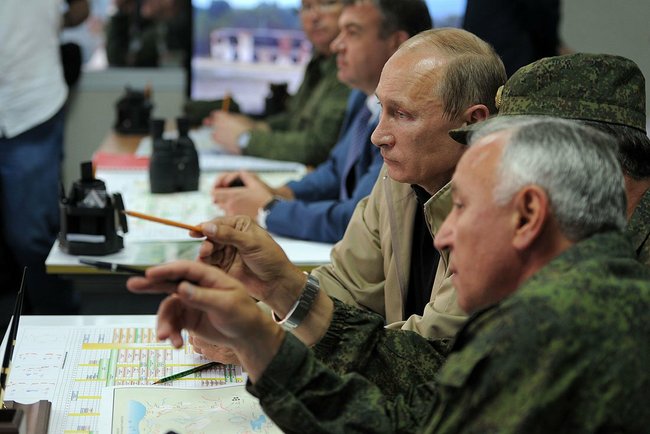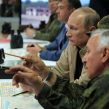
Kavkaz 2012 Rehearses Defense of Southern Russia
Publication: Eurasia Daily Monitor Volume: 9 Issue: 174
By:

Kavkaz 2012 (Caucasus 2012), the strategic command-staff military exercise staged in Russia’s Southern Military District (MD) from September 17 to September 23, tested key features of the reform of the Russian Armed Forces. In terms of the scenario and overall aims of the exercise, it appears to have been conceptually linked to Vzaimodeistviye 2012 held concurrently in Armenia, which witnessed the testing of the Collective Security Treaty Organization (CSTO) Rapid Reaction Forces (Kollektivnye Sily Operativnovo Reagirovaniya—KSOR) (Interfax, September 17–23).
Kavkaz 2012 highlighted a number of weaknesses in the Russian Armed Forces . These included the ongoing problems linked to deploying and sustaining forces in a theater of operations. Many of the units in the exercise were not only in position by the start of the event, but had spent considerable time in pre-exercise training. Moreover, issues stemming from the manning of the new brigade-based structure of the Russian military resurfaced, due to under-manning. Some sources indicated that these brigades are in fact up to 50 percent undermanned; thus, proving necessary to call up 300 reservists in order to fill missing positions in defense ministry units. Sources in the Russian Ministry of Defense stated that the existing level of reserve is weak due to the absence of follow-up training, and, in many cases, the reservists are selected on the basis of the need to fill the posts. One observer noted that a Navy reservist was assigned a grenade launcher role in the exercise (Izvestiya, September 19).
Moscow’s reluctance to allow foreign observers of Kavkaz 2012 and its allegedly sketchy details offered to NATO fueled speculation that it was hiding more sinister purposes in staging the exercise. This exercise, however, was the first to fully test the new automated command-and-control (C2) system at the brigade level. According to senior defense officials, it also involved testing new armaments; Colonel-General Aleksandr Galkin, the Commander of the Southern MD, said the overall aim was to examine the introduction of network-centric approaches to combat operations. Kavkaz 2012 tested and used command, control, communications, computers, intelligence, surveillance and reconnaissance (C4ISR) systems. No doubt these features were partly calculated to allow the top brass to convince the political leadership that the “new look” is making progress and thus ensure the continued money flow for the modernization process (Krasnaya Zvezda, September 17).
The 5th Motorized Rifle Brigade, Alabino, equipped with the prototype automated C2, and the staff of the 20th Army using the Akatsiya-M automated C2 system arrived at training ranges for Kavkaz 2012 as early as August 5. In July, airborne units were deployed on a testing range with their Andromeda automated C2, and during Kavkaz 2012, effort was made to integrate these systems (Izvestiya, September 12).
Although Russian officials dismissed any linkage between Kavkaz 2012 and attempts to intimidate Georgia, or even there being a Georgia-based element in the exercise, they were unusually quiet concerning precise details of the scenario. However, the Kavkaz 2012 exercise needs to be conceptually looked at as connected to Vzaimodeistviye 2012, in which KSOR rehearsed counter-terrorist operations. In other words, to avoid contravening the 1997 NATO-Russia founding act, which caps exercise totals at 10,000, the exercise was split into two sub-exercises with the former officially involving 8,000 personnel and the latter 2,000. This follows a pattern used in staging Zapad and Ladoga in September 2009 (Nezavisimoye Voyennoye Obozreniye, September 17).
During Kavkaz 2012, Russian operational-tactical aviation crews flying Su-24M and Su-25SM aircraft attacked “enemy columns and reserves,” while Tu-22M3 long-range bombers with Su-27 fighter cover launched strikes against “critically important enemy targets.” In the Caspian Sea, the scenario envisaged a “squadron of enemy amphibious ships” and “guard ships” attempting an amphibious landing. Missile ships in the Caspian Flotilla, Dagestan and Tatarstan and the missile boats Budennovsk and Borovsk were involved in a response that featured the use of the Kalibr-NK missile system. In the Black Sea, the Russian Navy rehearsed air defense against enemy parachute landings, and used cruise missiles to counter an enemy naval grouping and prevent an amphibious assault. And, according to Major-General Andrei Yudin, the Chief of the Air Force and Air Defense Command in Southern MD, the protection of Sochi from air attack during the 2014 Winter Olympics is a high priority security issue; this may have featured during Kavkaz 2012. Yudin believes that airspace over Sochi will be closed during the high-profile sporting event (Interfax, September, 18, 21; Krasnaya Zvezda, September 17).
The references in the reporting of Kavkaz 2012 to the hypothetical opponent or opponents envisaged in the scenario include the enemy making an “air landing,” using “air strikes,” “artillery,” and attempting in two locations (the Black Sea and Caspian Sea coasts) “amphibious assaults,” imply a high-technology adversary. The simulated naval enemy in the Caspian Sea was most likely Iran (Interfax, Krasnaya Zvezda, RIA Novosti, Nezavisimaya Gazeta, September 17–23). Kavkaz 2012, therefore, was about rehearsing the protection of southern Russia from highly equipped and capable conventionally armed adversaries. The response, though couched in terms of network-centric approaches in fact used a mainly traditional combined-arms operation.
Army-General Nikolai Makarov reported on the outcome of Kavkaz 2012 to President Vladimir Putin. In the midst of his “job well done” theme, Makarov admitted the exercise revealed “certain problems.” Makarov did not elaborate, but these may have been related to integrating automated C2, personnel issues, and movement of the brigades (www.kremlin.ru, September 21).
Considering Kavkaz 2012 and Vzaimodeistviye 2012 together as part of a larger exercise, it appears the central themes in the scenario were to rehearse the defense of southern Russia against a domestic crisis (possibly terrorist or insurgency related) and an external attack on Russia or a CSTO ally. The response involved securing the borders, inserting KSOR in Armenia, and employing conventional assets. Furthermore, the live firing of Iskander-M missiles during the exercises possibly suggests a rehearsal of a tactical nuclear use in a de-escalatory means against a mainly conventionally armed state actor or actors. It is possible to conclude, therefore, that while the reform and modernization were being examined during these exercises, the deeper concern in the General Staff is about escalation during a crisis on the Russian periphery.




